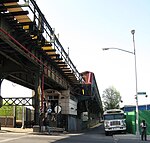Livonia Avenue station
1906 establishments in New York CityAccessible New York City Subway stationsBMT Canarsie Line stationsBrownsville, BrooklynEast New York, Brooklyn ... and 4 more
New York City Subway stations in BrooklynNew York City Subway stations located abovegroundRailway stations in the United States opened in 1906Use mdy dates from March 2020

The Livonia Avenue station (or Livonia Avenue-Junius Street station) is an elevated station on the BMT Canarsie Line of the New York City Subway. Located at the intersection of Livonia and Van Sinderen Avenues at the border of Brownsville and East New York, Brooklyn, it is served by the L train at all times.
Excerpt from the Wikipedia article Livonia Avenue station (License: CC BY-SA 3.0, Authors, Images).Livonia Avenue station
Van Sinderen Avenue, New York Brooklyn
Geographical coordinates (GPS) Address External links Nearby Places Show on map
Geographical coordinates (GPS)
| Latitude | Longitude |
|---|---|
| N 40.663745 ° | E -73.90048 ° |
Address
Livonia Avenue
Van Sinderen Avenue
11207 New York, Brooklyn
New York, United States
Open on Google Maps







